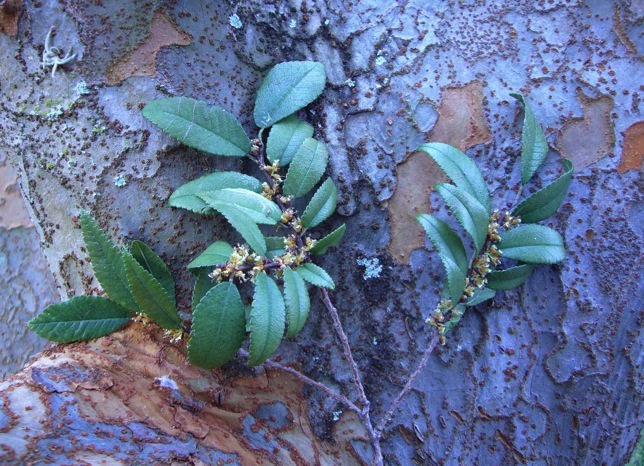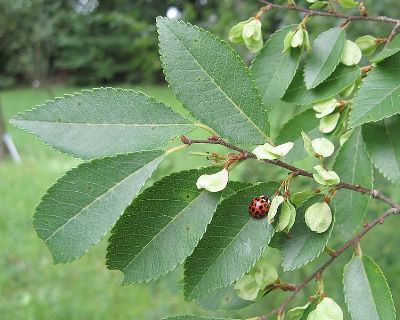Chinese Elm: A tree that doesn’t go Dutch
Sometimes a wild edible can be under your feet and you never notice, or in this case, over your head.
Anyone with any age on them will remember the huge elm trees that used to tower over many city streets in the United States. Then along came Dutch Elm Disease and these giant trees all but disappeared. I remember their demise for two reasons; how naked-looking many a main street looked after they were gone, and how hard it was to split elm wood. The tall graceful elm twisted when it grew– like the hatmatack — making the sizing and splitting for a wood stove back-straining work. My parents had a wood-fueled kitchen stove and a wood-fed cook stove in the basement. We also had a coal-burning neighbor who lost several large elms to the disease. Guess who got to split all that “free” wood?
Few trees can replace those great elms but a lot of smaller disease-resistant elms were imported from the orient about 80 years ago, among them the Chinese Elm, Ulmus parvifolia (UL-mus par-vih-FOLE-ee-uh.) Also called the Lacebark Elm, it’s the ornamental landscape tree of choice. It takes a nice shape, can be artistically weepy, and attractively sheds its bark leaving a mottled look making it very easy to identify. That’s good because it’s an edible and in many locales it has become naturalized. It has only one similar look alike, the Siberian Elm, Ulmus pumila, but the pumila has rough bark and fruits in the spring whereas the U. parvifolia has smooth bark and fruits in the fall. They’re both a tasty addition to the edible realm. The U. parvifolia is very common where I live with 16 of them less than 500 feet away. They flower about the first week of October here in Central Florida. The Siberian Elm is likewise edible but it flowers in the spring. Both trees are in season for only a couple of weeks to a month.
The prime food from them are the seeds, called samaras (SAM-ah-rah.) They are edible raw or cooked. For prime samaras get them while their wings are still green. They can be eaten as they are, or tossed into salads or cooked dishes. Once the samara have dried and their wings turned papery the seeds are still edible. Rub them free of the dry wings and eat the seeds raw or cooked.
The small young leaves of each tree are also edible raw or cooked, very mild with a slight hint of bitterness and a texture similar to New Zealand spinach. The inner bark of both is edible cooked as well, if you’re starving. (Incidentally, the inner bark of the Ulmus fulva, the Slippery Elm, not shown, is also edible and very nutritious. The Slippery Elm is also called Ulmus Rubraand prefers cooler climes.) While the Chinese Elm is said to be hardy from zones 5 to 9, it has been spotted growing from Canada to Florida, Maine to California. It’s a common hedgerow and windbreak tree in the midwest and extremely common on college campuses and in city parks as it is disease resistant, fast growing, attractive and essentially care-free. Ulmus is the ancient Roman name for that tree and parvifolia means small-leaved. Fulva means orange-yellow and pumila means dwarf. Rubra means red.
The only issue I have with the Chinese Elm is that nearly every description of the tree says the leaves have small hairs on the underside. I’ve never found any there. There are several varieties so perhaps my local ones do not have that fine fuzz. The best I’ve been able to find is just a few extremely tiny hairs on the stem of very new young leaves. While U. parvifolia can grow to 80-feet tall it’s also a bonsai favorite producing great results in only 20 years or so. In southern areas it can semi-evergreen or evergreen keeping its leaves all year. In northern climes its leave turn light yellow, red and purple in the fall. It seeds are eaten by purple finch, red-breasted grosbeak and when they can get them, the cottontail rabbit
And now for a bit of elm trivia. As a boy and young man I hated to size up elm for the two wood stoves we had in the house. It’s a hardwood and excellent for heating but the tree twists as it grows. This makes splitting very difficult because a piece will not cleave easily, like ash or pine. Even if it did split there would be snags holding the two pieces together and you’d have to attack it with an ax to finally separate them. Elm was a huge amount of work compared to other woods, except the Hackmatack, which also twisted. However, that same twisting growth made Elm perfect for wagon wheel hubs because they would not split when oak spokes were driven into them. Incidentally, the wooden rim of the wheel before covered with an iron band was made of ash because it is flexible. So a wooden wheel was made from three trees, the hub elm, the spokes oak because of strength, and the rim from ash, all held tight by a metal band put on when red hot which then shrinks as it cooled and holds everything tightly together.
Green Deane’s “Itemized” Plant Profile
IDENTIFICATION:
The Chinese Elm is among the easiest trees to identify because of its mottled bark. It exfoliates bark constantly giving it a jigsaw puzzle look of brown, orange and olive. Has typical elm leave, small, about one inch long, half inch wide, uneven base, dark green on top, rough with usually a dozen or less pair of veins. Underside light green.
TIME OF YEAR:
Samaras in season, spring with the pumila, fall with the parvifolia, later seeds when the wings have drive. Young leaves in season, inner bark any time.
ENVIRONMENT:
Likes sunny areas and moist soil. Usually found in planned landscapes (so make sure the soil and water are wholesome.)
METHOD OF PREPARATION:
Green samaras wings and seed, raw or cooked; dried samaras winnowed of the dry wings, raw or cooked. Young leaves raw or cooked, inner bark cooked. Small leaves of the American/Florida elm are also edible.
HERB BLURB
This 2006 study was designed to investigate the effect of medicinal herb extract on the antioxidant and antimicrobial activities against Helicobacter pylori, which is known as a ulcerogenic pathogen. The concentration of total phenolic compound of the Ulmus parvifolia was 15.12%), the highest among the ethanol extracts. The antioxidant activity of the ethanol extract of Ulmus parvifolia was 65.03% in DPPH assay. The antioxidant activity of the ethanol extract of Ulmus parvifolia was 27.70% in SOD assay. The antioxidant activity of the ethanol extract of the Ulmus parvifolia was 2.15in TBARS assay. Which all means it has antioxidant activity and is antibiotic.



